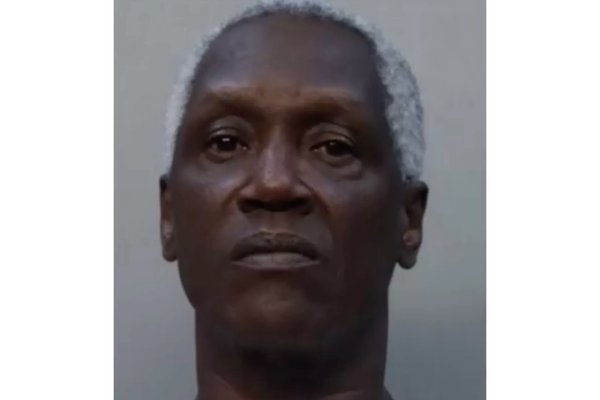
René Amuan Santiago Tí remembers how, armed only with wooden spears, he and his companions disarmed a group of policemen as they drew their pistols, after they caught the officers escorting a barge full of illegal mining machinery. The guns went in the river.
Disarming the police officers was a risky move, but the members of the Charip, as the Indigenous guards of the Wampis Nation people are known, were confident that something was amiss.
Charip means lightning, and for the territorial defenders it symbolises the way they strike against invaders of their land along the Santiago River, in the far north of Peru on its Amazonian frontier with Ecuador.
The three police officers, who were detained alongside Ecuadorian and Peruvian nationals in the incident in April 2024, were moonlighting as hired guns for illegal goldminers and were hundreds of miles from where they were based in Piura, a coastal region of Peru.
The Wampis refused to release them until the government sent a high-level commission to address the problem of wildcat goldminers plundering and polluting their land.
A few days later, a military helicopter carrying the deputy interior minister and the high commissioner against illegal mining touched down in Villa Gonzalo. Thousands of Wampis people had assembled in the village, its Charip warriors adorned in war paint. They demanded respect for their territory and action to expel the invaders.
Nearly a year later, the Charip guardians – rather than the state – have exerted control. They use stop-and-search at a checkpoint to thin out the number of mining dredgers upriver, says Santiago Tí, leader of the band of less than a dozen men who work day and night.
“We welcome visitors but will not allow people who come to do us harm,” he says. “If they come to extract gold or destroy our forest, then we are fierce. We are very protective of our forest.”
***
The Wampis people face a conundrum. They are the only Indigenous people in Peru to have created their own territorial government – an act of self-determination and a response to the state’s absence in the northern reaches of Condorcanqui province in the Amazonas region.
But while they have shown resilience and organisation in confronting illegal miners, they do not have the firepower to take on the criminal gangs behind the gold rush that is reaching ever deeper into Amazon border regions, as the international gold price surpasses $3,000 (£2,300) an ounce this month, a record high.
“We are seeing how different criminal economies are expanding their presence, territorial control and political influence in the Amazon,” says Raphael Hoetmer, western Amazon programme director at the environmental group Amazon Watch. “Organised crime is becoming a major threat to the global climate.”
The autonomous territorial government of the Wampis Nation was formed in 2017, a 13,000 sq km (5,000 sq mile) stretch of mountain and lowland rainforest across the Santiago and Morona river basins, with a population of about 15,000 people in 22 titled communities.
The nation was created under international laws that recognise the self-determination of Indigenous people, such as the Indigenous and Tribal Peoples Convention, which was enshrined in the Peruvian constitution.
River dredging for gold is prohibited in the territory, and the autonomous government has made clear its intention to seize and destroy any equipment found.
What the Charip members lack in resources, they make up for in spirit. From a wooden shed that resembles a birdwatching hide perched on the brow of a riverbank, they look out across the river. All vessels that pass – from canoes powered by puttering peque-peque motors to larger chalupas that carry passengers and goods – must stop to be inspected.
Each wears a donated bulletproof vest and carries a blackened nanki, a spear carved from tough chonta palm. One of them, Edgar Tí, is cordial as he inspects a boat that pulls up on the riverbank, registers the details on a clipboard, questions the driver and passengers, and checks for mining supplies such as plastic tubing, motor pumps or jerrycans of diesel.
Miners caught for the first time get off with a warning, but the Charip mete out Indigenous justice to reoffenders. They lash them with an ishanga, a type of Amazon nettle, or tie them for five minutes to a tangarana tree. This tree has a symbiotic relationship with aggressive fire ants, which attack any perceived threat to their home.
Santiago Tí says the nettles and ant bites, despite being painful, are used in traditional medicine to treat aches and pains, including arthritis. But chastised miners do not appreciate the punishment and several of the young men say they have received threats on instant messaging apps.
Older leaders, such as Alfonso Awananch Flores, the nation’s director of environment and territorial control, have been threatened, too. He says he avoids travelling to the larger towns since he was briefly abducted and interrogated.
“Without territory, we are not Wampis people,” says Flores, 45. That is why, he argues, they have strict management of their territorial autonomy and “cannot allow an activity that destroys our land, pollutes our river and poisons our fish”.
“We don’t need the state’s permission to declare our self-autonomy; we have been here for 7,000 years,” he says.
“We don’t need their recognition either. We have the right to become a territorial government.”
But they do need the armed forces to crack down on the dredgers, Flores admits, as the division between those opposed to mining and those who favour the illegal activity has split communities.
“We don’t want to create conflicts between families. That’s why we want the state to enforce the law,” he says.
***
Teófilo Kukush, the pamuk, or leader of the Wampis Nation, says miners are using children as “human shields” on dredgers to prevent the police and navy destroying the craft. “They pay the parents in communities to use their children,” says Kukush, who wears a red and yellow macaw feather crown signalling his status.
He is calling on the government to declare a state of emergency in the Santiago River and expel the miners.
“They make us fight among ourselves, and the mining groups have hired assassins who threaten us,” he says.
Downriver from the Charip checkpoint, some Wampis communities allow miners to work their riverbanks or creeks. The Guardian saw several dredgers and tracas, a raft-based mining platform with a directional tube that sucks up the silt containing gold grains from the river bottom, churning up the Amazon tributary into a coffee colour.
In Fortaleza, villagers do not welcome uninvited guests. An initial meeting with the village’s deputy leader, Joel Antich, is invaded by several drunk men. As an alarm sounds and the rest of the village gathers, the Guardian is accused of spying and asked to explain the motive of the visit. After an initially stormy reception, calm prevails.
The villagers claim the lack of state assistance leaves them with no option but to depend on dividends from miners. Some earn a day rate of 100 soles (£21) working on the barges.
“We know it’s illegal,” says Antich. “But we do it out of necessity.”
Juan Carlos Tuchia, a vocal advocate for miners, says the community has a fund that splits gold profits 50/50 with the miners. The income is being used to build a health clinic, build water-filtration plants and support needy families.
“We are not exploited by the miners,” he says. “We have no choice but to work with them because the state has abandoned us.”
He angrily accuses the Wampis Nation, without providing evidence, of filling its pockets with funds from the international community.
The health post has an aluminium roof, but the concrete walls are still under construction. Villagers say that a viewing stand for their football pitch has been built nearby using the proceeds from gold dredging.
The Charip territorial vigilance and Fortaleza’s reliance on miners are both responses to the state’s absence. Many villages lack electricity and clean drinking water, and crops such as cacao, peanut and cassava cannot compete with the income from a dredger that, they say, can process 100g a day, worth about $8,000.
“Indigenous organisations are fundamental in containing the expansion of illegal mining. But at the same time, this work is increasingly dangerous, as seen in the rise of assassinations of Amazonian Indigenous leaders,” says Hoetmer, calling for more support from the state and the international community.
“We want to live harmoniously within our territory without the greed of outsiders,” says Flores. “We are rich in nature. The poor are those who cannot survive without money.”







